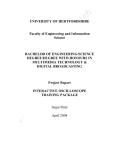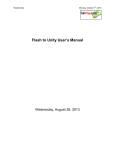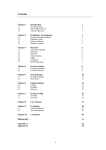Download Reminders Suggestions to Reduce Flash Frustrations during Project
Transcript
Reminders 1. Remember that the only ActionScript statements that may be on the frames in your .fla file are stop actions. All other ActionScript must be in your single .as file for your project. You will not receive credit for any other ActionScript on frames in your .fla file. 2. Remember that you need to create a user manual for your final project, which explains what your project is, how to use it, how and where you have fulfilled all of the project requirements, and how and where you have included extra features beyond the basic requirements. Create a user manual that follows the structure shown in the example user manual on the CISC 110 web page in the Labs, Assignments, Tests, and Project table. Suggestions to Reduce Flash Frustrations during Project Development Most of these have been suggested during lectures, but are listed again here. 1. If your project is mostly working, but occasionally you get an error message, don’t worry about it. Just hand your project in. 2. Use labels on your frames, which you then refer to in “gotoAndPlay” or “gotoAndStop” instead of frame numbers. Then if you add more frames, you don’t have to change those references. Create a frame label by selecting a frame and then looking at the Properties Window. Fill in the Name box under Label for the frame. For example, if you named a frame HomePage, then you can jump to that frame with the statement: ! ! gotoAndPlay( “HomePage” ); 3. If you get a “must be child of caller” error or start getting additional strange error messages that weren’t there before without making any changes, try restarting Flash. Sometimes the display list seems to become inaccurate. 4. One strategy to avoid null error problems and to simplify event listener management is to drag all of your display objects that will have interactivity (buttons, moveable movie clips) onto the stage in frame 1, but place them off to the side where they aren’t viewable. Add the listeners for all of these objects in your constructor function (your first function that has the same name as the class) and never remove them. When you want the user to have access to an object, either drag it onto the viewable portion of the stage at the frame you want or change its x and y position in your code at the appropriate place. An example of the second of these is shown in HangmanV1.as on our web page in the Week 11 Flash examples. The example HangmanV2.as shows how to do the same thing dynamically via using the addChild and removeChild methods, and adding and removing the listeners, but this is more error-prone.









